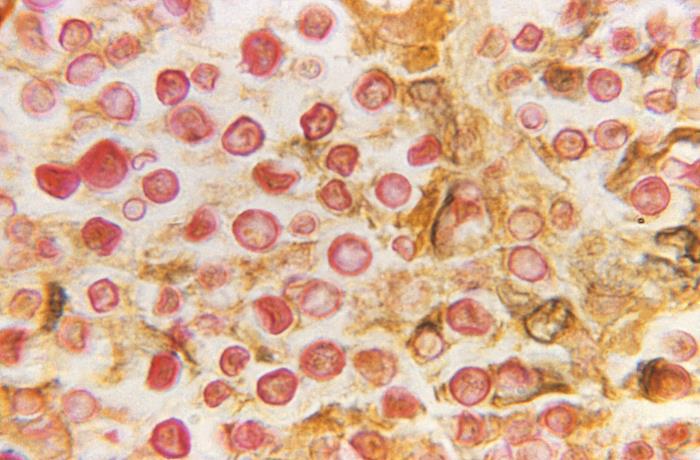Playlist
Show Playlist
Hide Playlist
Cryptococcosis – Opportunistic Infections
-
Slides 08 OpportunisticFungalInfections MicrobiologyAdvanced.pdf
-
Download Lecture Overview
00:01 So that's Candida, that's our first opportunistic infection, another one is Cryptococcosis caused by Cryptococcus neoformans. This is a common fungus in the soil. It's present in decaying wood, in tree hollows. It's present in bird droppings, so much like other fungi that we talked about before, soil can be enriched for these fungi when it happens to be near a bird coop or a place where birds are kept. But anyway it's a common environmental fungus. 00:34 You acquire the infection by inhaling the spores produced by the mycelial forms of cryptococci, the spores go into your lungs, where then they can reproduce disease, again this is an opportunistic infection, it typically occurs in immunosuppressed people, people with AIDS, hematologic malignancies, these are malignancies of the hematology system which can affect immunology and people with organ transplants. We've talked about a number of these infections now and you see a common theme, immunosuppression either causes the disease or makes it more frequent than we would normally see it. 01:15 About 20% of people who are diagnosed with Cryptococcosis are immunocompetent, at least they appear to be. So you may ask why is this an opportunistic infection, if this is the case. Well it's not clear that all of these people actually have intact immune systems, there may be subtle defects in their immune systems that allow them to be infected and I think as we do more genome sequencing in the next few years, we will find out if that in fact is the case. These infections are not contagious from person-to-person, although you inhale them by inhaling environmental molds, the spores formed by the fungus, you do not transmit them to other individuals. Cryptococcosis is a global substantial infectious disease. This is a graph showing the incidence of cryptococcal meningitis. So one of the places the Cryptococcus may go to is the brain, once it spreads from the lung in the immunosuppressed individual and it can cause meningitis. And you can see, many parts of the world have cryptococcal meningitis, but the most substantial burden is in sub-Saharan Africa, which is probably a combination of it being extremely dry and readily spreading the spores to individuals, and also the undeveloped healthcare system that leaves many people immunosuppressed, and of course the AIDS epidemic is probably underscoring most of these cases as well. 02:45 A million new cases every year and a substantial amount of debt, 625,000 cases. So to summarize, Cryptococccosis, again in most people, inhaling spores is not leading to any disease. Most infections are asymptomatic. When there is a symptom, even in an apparently immunocompetent patient, it's a lung infection. But when the fungus moves away from the lung, it can frequently cause meningitis. The yeast is neurotropic. It has a propensity for nerve cells and again in AIDS patients, you often see meningitis along with lung infiltrates, you see also skin lesions, you see widespread infection of many organs. So when the immune system is not able to contain the infection as most of us can readily do, the fungus spreads into many places. 03:44 How do you diagnose this infection? You can do a lumbar puncture and look at the CSF, the cerebrospinal fluid, for budding yeasts, you can also try and grow the yeast in culture and you can treat it with amphotericin B, flucytosine and fluconazole.
About the Lecture
The lecture Cryptococcosis – Opportunistic Infections by Vincent Racaniello, PhD is from the course Fungi.
Included Quiz Questions
Where is Cryptococcus neoformans commonly found outside of the human body?
- Soil
- Air
- Water
- Plants
- Uncooked meat
How does Cryptococcus neoformans invade the human body?
- Inhalation
- Sexual contact
- Blood transfusion
- Childbirth
- Fecal–oral transmission
Which of the following drugs is not used to treat Cryptococcus neoformans?
- Propranolol
- Amphotericin B
- Flucytosine
- Fluconazole
Customer reviews
5,0 of 5 stars
| 5 Stars |
|
5 |
| 4 Stars |
|
0 |
| 3 Stars |
|
0 |
| 2 Stars |
|
0 |
| 1 Star |
|
0 |




